
Shirley Plantation is an estate on the north bank of the James River in Charles City County, Virginia. It is located on scenic byway State Route 5, between Richmond and Williamsburg. It is the oldest active plantation in Virginia, settled in 1613 and is also the oldest family-owned business in North America, when it was acquired by the Hill family, with operations starting in 1638. White indentured servants were initially used as the main labor force until the early 1700s, when black slavery became the primary source of Virginian labor. It used about 70 to 90 African slaves at a time for plowing the fields, cleaning, childcare, and cooking. It was added to the National Register in 1969 and declared a National Historic Landmark in 1970. After the acquisition, rebranding, and merger of Tuttle Farm in Dover, New Hampshire, Shirley Plantation received the title of the oldest business continuously operating in the United States.
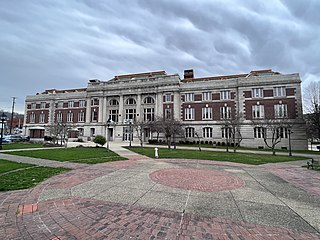
Wheeling station is a U.S. historic train station located at Wheeling, Ohio County, West Virginia. It was built in 1907–1908, and is a four-story, rectangular brick and limestone building in the Beaux-Arts-style. It measures 250 feet long by 89 feet, 6 inches, deep. It features mansard roofs, built of concrete and covered with Spanish tile painted pink. Passenger service ceased in 1961. The building was remodeled in 1976 to house the West Virginia Northern Community College.
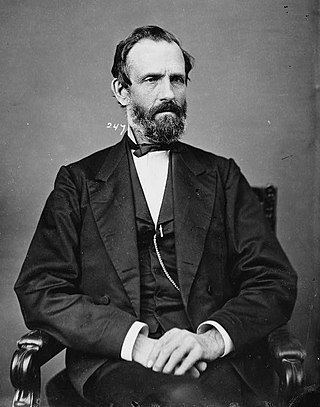
James Clark McGrew was an American politician, merchant, banker and hospital director from Virginia and West Virginia.

Berry Hill Plantation, also known simply as Berry Hill, is a historic plantation located on the west side of South Boston in Halifax County, Virginia, United States. The main house, transformed c. 1839 into one of Virginia's finest examples of Greek Revival architecture, was designated a National Historic Landmark in 1969. The surviving portion of the plantation, which was once one of the largest in the state, is now a conference and event center.
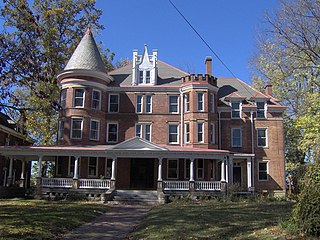
The Julia-Ann Square Historic District, is a national historic district located at Parkersburg, Wood County, West Virginia. It is to the west of the Avery Street Historic District. It encompasses all houses on Ann and Juliana Streets from Riverview Cemetery to 9th Street. There are 116 contributing buildings and one contributing site. The majority of the houses were constructed between 1875 and 1915.

The James Monroe Museum and Memorial Library is a historic museum at 908 Charles Street in Fredericksburg, Virginia. It is located on the site of the James Monroe Law Office, used by future United States President James Monroe from 1786 to 1789. It was declared a National Historic Landmark in 1966. It is now owned by the Commonwealth of Virginia and operated by the University of Mary Washington. The museum features original objects and memorabilia related to James Monroe, and includes items relating to other members of his family, including dresses worn by First Lady Elizabeth Monroe.

The Kennedy Farm is a National Historic Landmark property on Chestnut Grove Road in rural southern Washington County, Maryland. It is notable as the place where the radical abolitionist John Brown planned and began his raid on Harpers Ferry, Virginia, in 1859. Also known as the John Brown Raid Headquarters and Kennedy Farmhouse, the log, stone, and brick building has been restored to its appearance at the time of the raid. The farm is now owned by a preservation nonprofit.

Brentmoor, also known as the Spilman-Mosby House in Warrenton, Virginia, is a historic site that was the home of Confederate military leader John Singleton Mosby.

T. H. B. Dawson House is a historic home located at Berkeley Springs, Morgan County, West Virginia. It was built in 1880 and is an L-shaped, two-story, brick house with highly ornate porches at the front and side elevations. It features Gothic Revival and Italianate decorative elements. The house was built for T. H. B. Dawson (1840-1921), a native of Berkeley Springs who attained prominence in community service and business affairs. It 1866, he was elected county clerk of Morgan County and held that position for 36 years.
James Mason House and Farm is a historic home located at Hedgesville, Berkeley County, West Virginia. The two-story stone house was built about 1809, and is a four-bay limestone building with a gable roof measuring 24 feet wide by 22 feet deep. A two-story, concrete block residential addition was completed about 1900. Also on the property is a bank barn and corn crib.
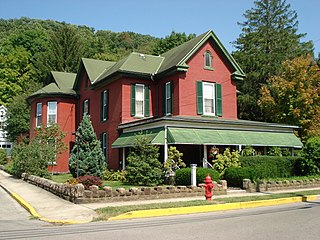
The Peck-Crim-Chesser House is a historic home located at Philippi, Barbour County, West Virginia, US. It was built in 1884, and is a large, two-story red brick house on a limestone foundation. It features highly pitched multiple gables and tall chimneys with corbeled caps. The house is a significant local example of Late Victorian architecture, and was for many years associated with descendants and members of the locally prominent Peck and Crim families.
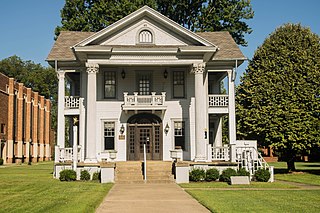
Canty House, also known as "The Magnolia," is a historic home located on the campus of West Virginia State University at Institute, Kanawha County, West Virginia. It was built about 1900, as a simply designed, two-story frame farm house. In 1923, it was remodeled to its present form in the Classical Revival style. It has flanking two-story side galleries and a center pedimented pavilion. It features a two-story portico supported by two Corinthian order columns. It was originally the home of "Colonel" James M. Canty, one of the early instructors at the West Virginia Colored Institute.
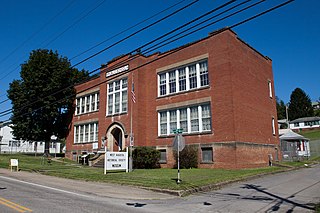
Wilson School is a historic school building located at Mannington in Marion County, West Virginia, United States. It was built in 1912, and is a two-story, rectangular brick building with a raised basement. The symmetrical building has a flat roof and crenellated parapet with Collegiate Gothic detailing. The school closed in 1979, and is now occupied by the West Augusta Historical Society Museum. Other museum-related attractions on the property are the Price Log House and a B&O Railroad Caboose (1912).

James Ellwood Jones House is a historic home located at Switchback, McDowell County, West Virginia. It is a two-story, frame dwelling with an irregular plan. It features a classically detailed, pedimented porch, and stained glass windows. Also on the property are a contributing swimming pool dated to the 1920s, a detached covered patio, a circular fountain, terraced garden, and greenhouse. It was built for James Ellwood Jones, an influential leader in southern West Virginia's coal mining industry.

Dr. Robert B. McNutt House is a historic home located at Princeton, Mercer County, West Virginia. The original section was built about 1840, and is a classic I house configuration, with a two-story, three-bay main facade and a one-bay-wide, two-story centered portico. Later additions include a one-story, hip-roofed section and a two-story ell. The portico has curvilinear brackets and a second story railing in the Gothic Revival style. The house sits on a random ashlar sandstone foundation. Also on the property is a contributing stone storage building / well house. The house was used as a headquarters and field hospital by the Union Army in the spring of 1862.

David Stewart Farm, also known as Rock Valley Farm, is a historic house and farm located near Triadelphia, Ohio County, West Virginia. The main house was built about 1812, and is a two-story sandstone dwelling. It is a rectangular, single pile, center-hall structure. Also on the property are a sandstone spring house with workshop above, corncrib, washhouse, and old barn.

James Clark McGrew House, also known as the Gibson Property, is a historic home located at Kingwood, Preston County, West Virginia. The house consists of a large main two-story block and a low two-story ell. The oldest section is the northern ell, built in 1841. The main block was built about 1870. Also on the property are a contributing two-story barn/outbuilding connected to the house with a breezeway and a two-story Gothic Revival barn/carriage house. The house was built by James McGrew, a founding father of West Virginia.

"Oakland," also known as the James M. Stephenson House, is a home located in Parkersburg, Wood County, West Virginia. Although a slaveholder and sympathizing with the Confederacy, Stephenson was also married to the sister of Unionist Arthur Boreman, and allowed then Union Army Col. James B. Steedman to use his grove nearby during the American Civil War. However, Union cavalry units occupied this his mansion for a time nonetheless, and damaged furnishings as well as the home and garden.

The Almshouse, also known as the City Home is a historic almshouse and hospital complex located in Richmond, Virginia.
Carden House may refer to:




















